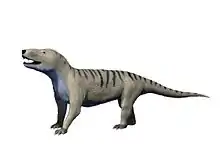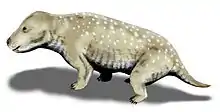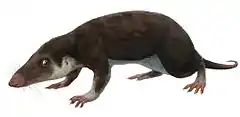Xenocretosuchus
Xenocretosuchus is an extinct genus of tritylodont therapsids from the Aptian (Early Cretaceous) Ilek Formation of Siberia, in the Russian Federation.[1] The type species, X. sibiricus, is known only from dental elements,[2] as is X. kolossovi, described from the Batylykh Formation in 2008.[3] Both species may be part of the genus Stereognathus.[4]
| Xenocretosuchus | |
|---|---|
| Scientific classification | |
| Kingdom: | Animalia |
| Phylum: | Chordata |
| Clade: | Therapsida |
| Clade: | Cynodontia |
| Family: | †Tritylodontidae |
| Genus: | †Xenocretosuchus Tatarinov & Matchenko, 1999 |
| Type species | |
| Xenocretosuchus sibiricus Tatarinov & Matchenko, 1999 | |
| Other species | |
| |
Alongside Montirictus,[5] it is the latest known non-mammalian synapsid (excepting the perhaps also not-mammalian[6][7] haramiyidan Avashishta[8][9]), extending their range to the Early Cretaceous.
References
- Fossilworks. "Xenocretosuchus." Retrieved from
- Palaeos. "Cynodontia: Tritylodontidae." Retrieved from
- Lopatin & Agadjanian, 2008. "A Tritylodont (Tritylodontidae, Synapsida) from the Mesozoic of Yakutia." Retrieved from
- Averianov, A.O.; Martin, T.; Lopatin, A.V.; Schultz, J.A.; Skutschas, P.P.; Rico, S.; Krasnolutskii, S.A. (2017). "A tritylodontid synapsid from the Middle Jurassic of Siberia and the taxonomy of derived tritylodontids". Journal of Vertebrate Paleontology. 37 (5): e1363767. doi:10.1080/02724634.2017.1363767.
- Hiroshige Matsuoka, Nao Kusuhashi and Ian J. Corfe (2016). "A new Early Cretaceous tritylodontid (Synapsida, Cynodontia, Mammaliamorpha) from the Kuwajima Formation (Tetori Group) of central Japan". Journal of Vertebrate Paleontology. Online edition: e1112289. doi:10.1080/02724634.2016.1112289.
- Chang, Kenneth (16 November 2015). "Jawbone in Rock May Clear Up a Mammal Family Mystery". New York Times. Retrieved 17 November 2015.
- Luo, Zhe-Xi; Gates, Stephen M.; Jenkins Jr., Farish A.; Amaral, William W.; Shubin, Neil H. (16 November 2015). "Mandibular and dental characteristics of Late Triassic mammaliaform Haramiyavia and their ramifications for basal mammal evolution". PNAS. 112 (51): E7101–E7109. doi:10.1073/pnas.1519387112. PMC 4697399. PMID 26630008. Retrieved 17 November 2015.
- S. Anantharaman, G. P. Wilson, D. C. Das Sarma and W. A. Clemens. 2006. A possible Late Cretaceous "haramiyidan" from India. Journal of Vertebrate Paleontology 26(2):488-490
- Ashok Sahni, New evidence for palaeogeographic intercontinental Gondwana relationships based on Late Cretaceous-Earliest Palaeocene coastal faunas from peninsular India, Washington DC American Geophysical Union Geophysical Monograph Series 01/1987; 41:207-218. DOI: 10.1029/GM041p0207
This article is issued from Wikipedia. The text is licensed under Creative Commons - Attribution - Sharealike. Additional terms may apply for the media files.







